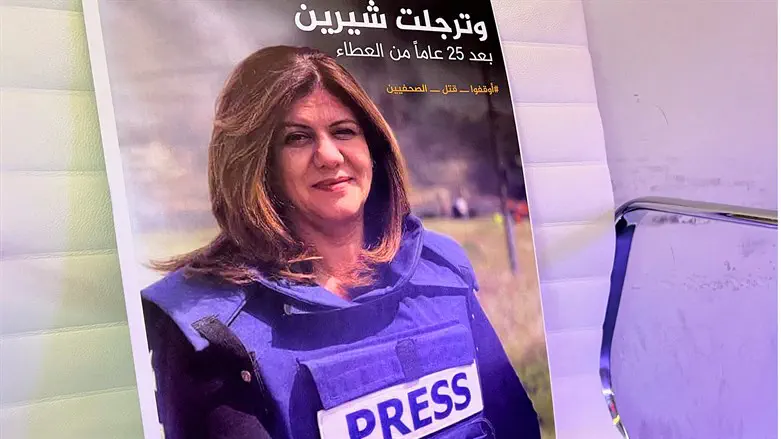
Shireen Abu Aqleh, a veteran journalist with Al Jazeera, was killed two weeks ago in Jenin while covering an exchange of fire between Israeli special forces and Palestinian terrorists, and the furor around the incident has yet to die down.
Immediately following the fatal shooting, Palestinians accused Israel of having deliberately targeted her, but the Palestinian Authority categorically turned down Israel's request to hold a joint investigation into the death, including making the bullet available for a mutually agreed-upon forensics expert to analyze.
Meanwhile, global media, led by CNN, has already made up its mind on what happened that day and continues to pronounce Israel guilty of actually murdering Abu Aqleh, relying on Palestinian accounts of what happened. According to prominent Israel physician Nachum Shachaf, however, the truth is the opposite of what media sources are claiming.
Back in 2000, it was Shachaf who proved that IDF forces were not guilty of the fatal shooting of Muhammad al-Dura in Gaza. Shachaf has now examined the footage and pictures from the shooting of Abu Aqleh and reached the conclusion that she was shot and killed by Palestinians.
"I did more than just theoretically examine the case - I actually went to the place where it occurred," Shachaf said of the al-Dura shooting. "I spoke to the soldiers who had been there, and interviewed the France 2 journalist, Talal Abu Rahma, who had filmed the alleged shooting, and I even succeeded in extracting from him the admission that it had not been IDF soldiers who shot al-Dura."
On the events in Jenin two weeks ago, Shachaf notes that, "In the pictures and footage, you can seen an armed Palestinian shooting in the direction of the building next to which Abu Aqleh and two of her colleagues from Al Jazeera were standing. A little later, another two journalists made their way there. There were seven Al Jazeera journalists there in total," Shachaf points out, "and what I would like to know is: why? I don't want to reach premature conclusions, but it does certainly appear that someone told them to expect something to happen that morning, as otherwise, there's no way to explain why seven journalists suddenly turned up to cover an IDF operation of the kind that takes place every other day.
"They are much more cunning than we are," Shachaf adds, in explanation of why the IDF can win on the battlefield but then loses the public relations war. "They don't have any boundaries. And yet, they publicized the video in which we can see this armed Palestinian shooting toward the building next to which Abu Aqleh was standing, and you can actually see him shooting not at the Israeli forces there, but toward Abu Aqleh herself. This incident was designed to humiliate Israel on the world stage," he alleges.
He also cites the words spoken by one of the Palestinians who was at the scene, also documented: "We hit someone." The words were widely interpreted as referring to an IDF soldier, but in fact no IDF soldiers were wounded in the firefight. According to Shachaf, the Palestinian likely saw Abu Aqleh from a distance, lying on the ground, and owing to her bullet-proof vest and helmet, he mistook her for a soldier that the terrorists had succeeded in hitting.
"The IDF wanted a chance to examine the bullet extracted from Abu Aqleh and also to see the pathologist's report," he adds. "If the terrorist organizations were so certain that the Israeli forces had shot her, what's the problem with revealing the bullet, the size of the bullet-hole, and the pathologist's report? Even without the bullet, its entry-point can be measured, which establishes the size of the bullet that made it." He notes that the Kalashnikov rifles used by the terrorists have a larger size bore than the guns used by the IDF, and that it would therefore be a simple matter to determine who shot her.
From the stills and video shots of the incident, Shachaf notes, "it's clear that the journalists were standing behind a wall. The wall hid them from the IDF forces who were on the other side, further away. No shots could have penetrated that wall, and the same was the case with the shooting of al-Dura, as we showed from the investigation we conducted there at the time." According to Shachaf, the Al Jazeera journalists were standing in a spot that was protected from behind, from their right, and from in front of them, and was only open to their left, facing the Palestinian terrorists who were firing wildly, in the vague direction of the IDF forces.
"There are a few other interesting points regarding the distances involved," he adds. When asked if he really believes the Palestinians could have shot one of their own, he notes that Abu Aqleh was a Christian, and therefore her death was not seen as such a terrible thing.
Shachaf also recalls that at the time of the al-Dura incident, international media were also quick to assume and pronounce the guilt of the Israelis, but once proven wrong, they denied ever having made their accusations, despite all evidence to the contrary. As such, even if the death of Abu Aqleh is ever proven conclusively to have been due to Palestinian fire, expect no apology to be forthcoming from CNN, AP, or anyone else.